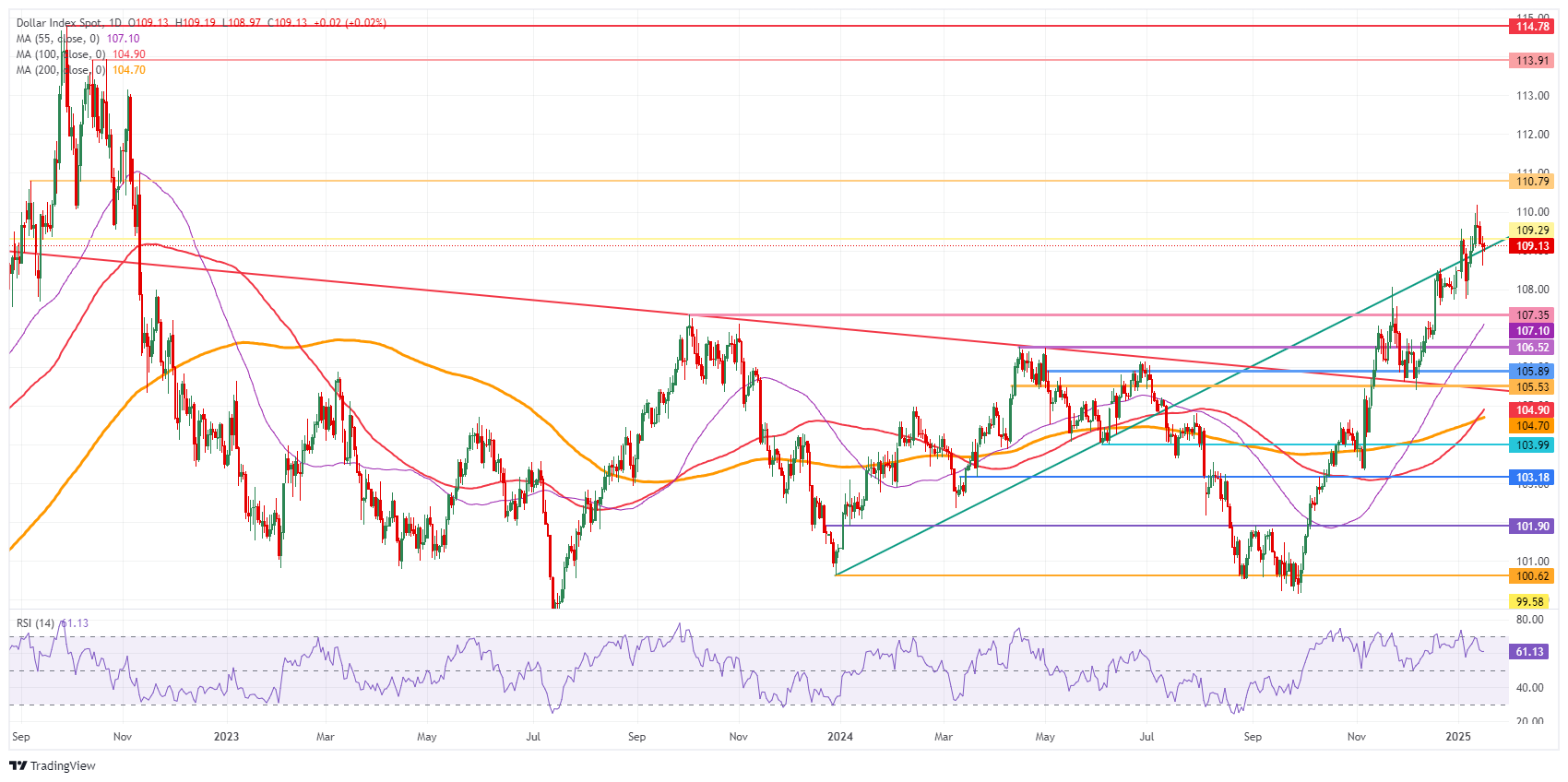US Dollar stabilizes ahead of US Retail Sales data
- The US Dollar steadies ahead of US Retail Sales data for December on Thursday.
- Markets see yields collapse, with rate-cut expectations taking over.
- The US Dollar Index (DXY) holds around 109.00 but could dip further if US yields sink even more.
The US Dollar Index (DXY), which tracks the Greenback’s value against six major currencies, halts this week’s correction and stabilizes around the 109.00 level on Thursday. This week's poor performance is fully due to the decline in US yields. For example, the US 10-year benchmark fell 2.5% in just one trading day due to mixed US Consumer Price Index (CPI) numbers, which could have been seen as disinflationary. In case US yields surge again, the Greenback could head back to 110.00 and higher.
This Thursday's economic calendar is filled with interesting data points. First and foremost is the US Retail Sales number for December, followed by the weekly Initial Jobless Claims. Later in the day, the National Association of Home Builders (NAHB) Housing Market Index for January could also become interesting.
Daily digest market movers: Retail Sales to set the record straight?
- At 13:30 GMT, the US Retail Sales and the weekly Jobless Claims will be released:
- The monthly Retail Sales are expected to increase by 0.6% in December, compared to 0.7% the previous month. As always, the revisions will be more market-moving than the actual release.
- Initial Jobless Claims for the week ending January 10 are expected to tick up to 210,000 from 201,000 in the previous week.
- The Philadelphia Fed Manufacturing Survey for January is also due in that same time slot. Expectations are for a smaller contraction of -5 compared to the previous -16.4.
- At 15:00, the NAHB Housing Market Index for January will be released. The expectation is that it will tick down to 45, compared to 46 in the previous reading.
- Equities are holding up quite well for the second day in a row. Both European and US equities are trading positive on the day.
- The CME FedWatch Tool projects a 97.3% chance that interest rates will be kept unchanged at current levels in the January meeting. Expectations are for the Federal Reserve (Fed) to remain data-dependent with uncertainties that could influence the inflation path once President-elect Donald Trump takes office on January 20.
- The US 10-year yield is trading around 4.667%, over 2.5% lower than its peak performance this week on Tuesday at 4.807%.
US Dollar Index Technical Analysis: Markets should not be happy
The US Dollar Index (DXY) takes a step back and is either on the verge of salvaging this rally or at risk of a harsh correction. Although markets might be rejoicing, mixed inflation data perceived as disinflationary will not have the Federal Reserve committing to anything at any time. Inflation might still elope and start turning hot and higher again, which would mean much more upside for the DXY, with markets being currently wrong-footed based on just one ‘mild’ disinflationary report at the start of the year.
On the upside, the 110.00 psychological level remains the key resistance to beat. Further up, the next big upside level to hit before advancing any further remains at 110.79. Once beyond there, it is quite a stretch to 113.91, the double top from October 2022.
On the downside, the DXY is testing the ascending trend line from December 2023, which currently comes in around 108.95 as nearby support. In case of more downside, the next support is 107.35. Further down, the next level that might halt any selling pressure is 106.52, with interim support at the 55-day Simple Moving Average (SMA) at 107.10.
US Dollar Index: Daily Chart
Employment FAQs
Labor market conditions are a key element to assess the health of an economy and thus a key driver for currency valuation. High employment, or low unemployment, has positive implications for consumer spending and thus economic growth, boosting the value of the local currency. Moreover, a very tight labor market – a situation in which there is a shortage of workers to fill open positions – can also have implications on inflation levels and thus monetary policy as low labor supply and high demand leads to higher wages.
The pace at which salaries are growing in an economy is key for policymakers. High wage growth means that households have more money to spend, usually leading to price increases in consumer goods. In contrast to more volatile sources of inflation such as energy prices, wage growth is seen as a key component of underlying and persisting inflation as salary increases are unlikely to be undone. Central banks around the world pay close attention to wage growth data when deciding on monetary policy.
The weight that each central bank assigns to labor market conditions depends on its objectives. Some central banks explicitly have mandates related to the labor market beyond controlling inflation levels. The US Federal Reserve (Fed), for example, has the dual mandate of promoting maximum employment and stable prices. Meanwhile, the European Central Bank’s (ECB) sole mandate is to keep inflation under control. Still, and despite whatever mandates they have, labor market conditions are an important factor for policymakers given its significance as a gauge of the health of the economy and their direct relationship to inflation.

